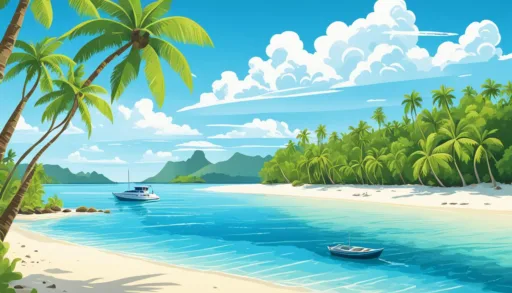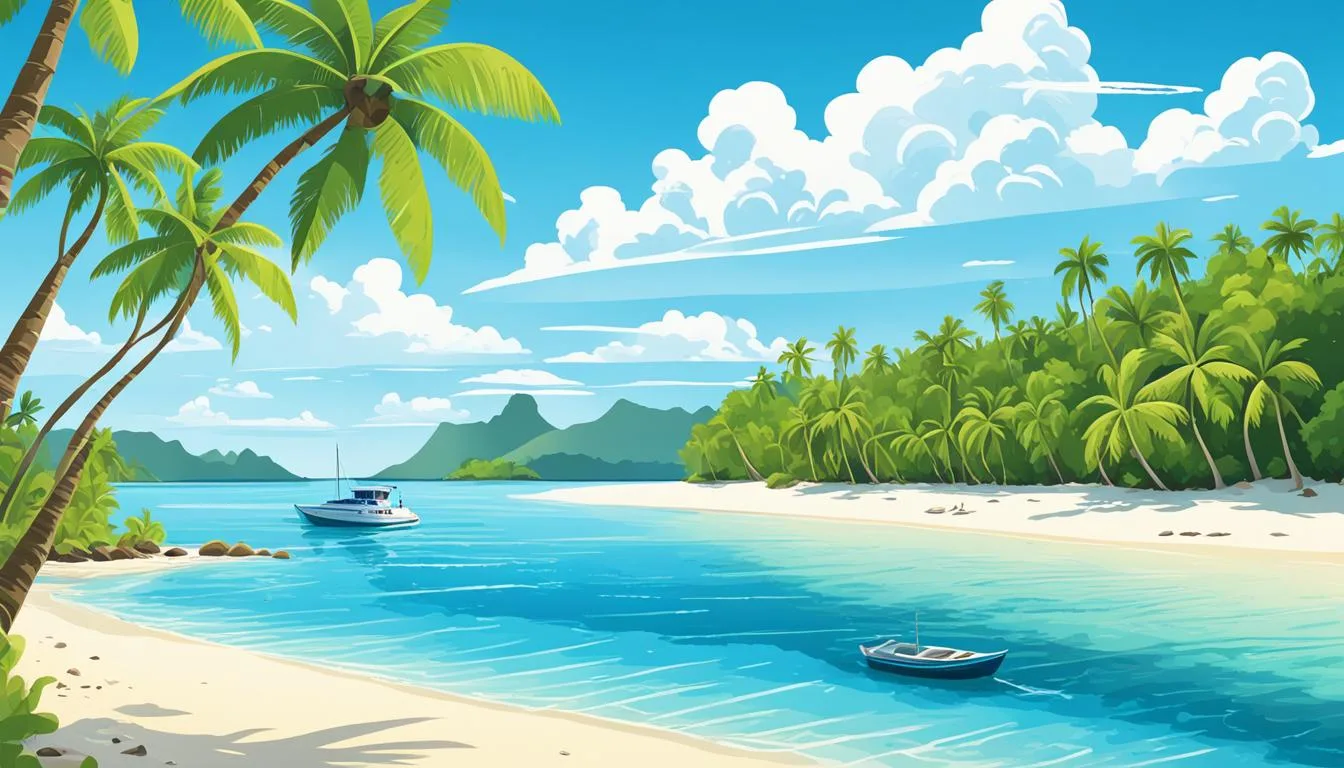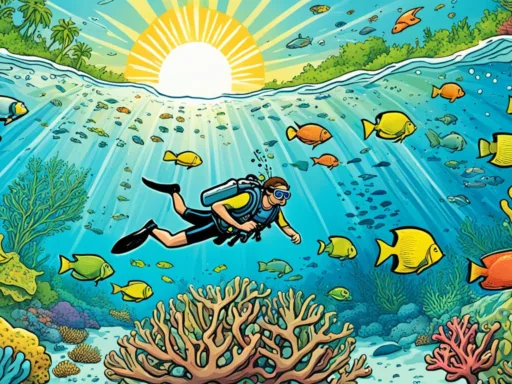When we think of paradise, it’s often a sun-soaked escape that comes to mind. But what if the key to uncovering the full splendor of a tropical haven like Micronesia lies in knowing its secretive seasons? Think beyond the standard advice for Micronesia travel season, and dive into an enriching journey that aligns your wanderlust with the Best Time to Visit Micronesia. Whether seeking the thrill of diving adventures in unspoiled coral havens or the laid-back joy of island hopping, timing is everything—a well-planned trip can unlock the true essence of Micronesia tourism.
Embark on a quest to find that perfect time when the crystalline waters beckon with a special kind of clarity, and the marine life playfully engages with ocean explorers. Micronesia’s cluster of islands, each with its seasonal rhythms and underwater marvels, offers a kaleidoscope of adventures waiting to be discovered. In the following guide, we’ll explore why the islands’ lesser-known travel periods might hold the secrets to an unmatched Pacific escapade.
Key Takeaways
- Discovering the optimal Micronesia travel season for personalized experiences.
- Insights into the unique marine events and the best seasons for diving adventures.
- How regional weather patterns can influence your island hopping itinerary.
- Understanding the balance of Micronesian tourism away from the crowds.
- Embracing seasonal fluctuations to unveil the most vibrant underwater ecosystems.
Introduction to the Pristine Beauty of Micronesia
Comprising over 600 islands, Micronesia is a remote paradise waiting to be discovered by intrepid travelers. With an assemblage of islands such as Yap, Chuuk, Kosrae, and Pohnpei, along with the bewitching Palau, the region is an aquatic sanctuary for those who yearn for vibrant, unspoiled dive sites. Each island is an alluring escape, offering an underwater safari of pelagic magnificence, coral gardens teeming with life, and historical treasures gently resting on the seabed.
For marine enthusiasts and eco-tourists alike, Micronesia’s weather patterns provide near perfect conditions for exploration, characterized by warm, crystalline waters year-round. Reputed for its large pelagic sightings, this diver’s paradise also invites you to witness some of the most spectacular wreck diving sites the world has to offer. The allure of this Micronesia travel guide section lies in the promise of adventure within Kosrae’s living kaleidoscope of corals, a true testament to the untouched beauties of the deep.
- Yap: Best known for its manta ray cleaning stations and traditional stone money.
- Chuuk (Truk): Home to the famous Chuuk Lagoon with over 60 submerged shipwrecks.
- Kosrae: A hidden gem with pristine reefs and exceptional biodiversity.
- Pohnpei: Featuring Nan Madol, the “Venice of the Pacific,” and lush rainforests.
- Palau: Offers thrilling drift dives, vibrant reefs, and the unique Jellyfish Lake.
Embrace the essence of Micronesia – a region that transcends the ordinary with its harmonious symphony of land and sea. The adventurous spirit will find no better sanctuary than in these islands, where tradition intertwines with natural splendor, creating a tapestry as rich and diverse as the cultures that thrive upon its shores.
Best Time to Visit Micronesia
For those contemplating a Micronesia vacation, understanding the region’s climate and the best periods for marine explorations is key to a successful journey. Situated in a tropical zone, Micronesia’s warm, clear waters beckon travelers and diving enthusiasts all year round, offering varying attractions as the seasons change. Below, we delve into the nuances of Micronesia’s weather patterns, marine highlights, and regional differences in diving seasonality to help you perfectly time your Micronesian adventure.
Weather Patterns Across Micronesia
With an equatorial climate, Micronesia’s climate is predominantly tropical and influenced by the oceanic surroundings. The temperature remains fairly consistent, but rainfall can differ significantly from island to island. While regions such as Yap and Kosrae experience their heaviest rains from December through April, Chuuk and Palau typically see more precipitation from May to November. These variations in weather patterns can influence the Micronesia vacation tips and travel advice you may receive, recommending the optimal time for a visit based on your preferences for sunny skies or cooler, overcast days.
Seasonal Marine Life Highlights
The Micronesian marine life thrives under the surface of its pristine waters, offering dynamic diving conditions and underwater encounters that change with the seasons. During the wetter months in Yap and Kosrae, divers have the spectacular opportunity to observe migratory whales and playful dolphins alongside resident manta rays and reef sharks. Throughout these islands, the lush marine biodiversity is a constant presence, but visitors in these particular months may witness the natural spectacle unique to the season.
Regional Differences in Diving Seasonality
While Micronesia offers excellent diving throughout the year, regional differences can offer a distinct experience depending on your timing. Chuuk Lagoon, with its sunken fleet from WWII, is world-renowned for wreck diving, particularly in December, when visibility is often at its best. In contrast, Palau is famous for its pelagic action and the mesmerizing Jellyfish Lake, with Palau diving conditions often being most favorable during the dry season, offering clearer waters and improved visibility.
Certainly, the diverse Micronesia tourist attractions both above and below the water line present opportunities for unique travel experiences all year round. Whether your interests lie in the World War II wrecks of Chuuk Lagoon or the vibrant coral reefs and pelagic-rich waters of Palau, timing your trip with the local diving conditions and marine life sightings in mind will maximize the magic of your Micronesian vacation.

Dive into Micronesia’s Diving Hotspots
When it comes to unparalleled underwater adventures, scuba diving in Micronesia certainly makes a splash. Palau and Yap are among the region’s premier destinations, offering a diverse range of dive experiences suited to every level of expertise. Palau’s strong currents challenge the experienced diver, while Yap’s serene waters welcome novices with open arms.
Here’s a snapshot of what each Micronesian diving hotspot has to offer:
| Location | Type of Dives | Marine Life Highlights | Experience Level |
|---|---|---|---|
| Chuuk Lagoon | Wreck dives | Historical WWII ships | Intermediate to Advanced |
| Palau | Current, reef, and jellyfish lake dives | Sharks, manta rays, jellyfish | Intermediate to Advanced |
| Yap | Manta ray and macro marine life encounters | Manta rays, mandarin fish, reef life | Beginner to Intermediate |
Whether you’re gliding alongside gentle manta rays in the enchanting waters of Yap or navigating through the historic wrecks of Chuuk Lagoon, each site delivers a distinct underwater narrative. For those with a penchant for pelagic action, the swift currents of Palau’s dive sites teem with sharks and other predatory fish, turning every dive into an exhilarating chase.
- Chuuk Lagoon: dubbed the ‘Ghost Fleet’ for its abundance of sunken WWII vessels
- Palau: renowned for its dramatic wall dives and the ethereal Jellyfish Lake
- Yap: sought-after destination for diving with majestic manta rays
Scuba diving in Micronesia presents a kaleidoscope of underwater wonders, making it a dream destination for divers searching for both adventure and tranquility beneath the waves.
Exploring Micronesian Culture and Traditions on Land
Micronesia offers a vivid tapestry of cultures, each with distinctive local customs and spectacular Indigenous art. The islands are not just a diver’s paradise but are also a treasure trove for those seeking to immerse themselves in rich cultural experiences. Tradition runs deep in the soil of Micronesia, where ceremonial dances, local crafts, and communal feasts form the backbone of society.
Cultural Heritage of Each Island State
The fabric of Micronesian culture is woven with tales and legends that have been passed down through generations. Numerous ethnic groups including Chuukese, Pohnpeian, Kosrean, and Yapese inhabit the islands, each cultivating their own form of Indigenous art and traditional practices. Yap is renowned for its ancient dances, a display of grace and tradition that communicates stories and legends of the past. Kosrae, with its elaborate weaving techniques, preserves the artistry of its ancestors through vibrant textiles and garments.
Feasting and Festivities in Micronesia
Traditional dances and Micronesian festivities are at the heart of local customs, reflecting a community-centred society where life’s milestones are celebrated collectively. Feasts bring people together, creating a sense of unity and continuity among the island communities. These social occasions, featuring abundant local cuisine, signify the importance of food not just as sustenance but as a medium of bonding and expression of social and symbolic values. Through vibrant communal gatherings, Micronesia keeps the spirit of its ancestors alive, celebrating the essence of their way of life where family and community prevail.
Island Hopping and Accommodation Options
For those planning a Micronesia travel guide itinerary, the accommodation choices are as diverse as the islands themselves. From the immersive experience of liveaboards to the comfort of shore-based dive resorts, there’s a perfect fit for every traveler’s preference. Surveying the options for accommodation in Micronesia is the first step towards a memorable journey through this aquatic paradise.

Liveaboards vs. Shore-Based Resorts
Choosing between liveaboards and resort stays can influence the scope of your Micronesia diving adventure. Liveaboards cater to those looking to maximize their underwater time, with multiple daily dives, and the convenience of waking up at new dive sites each day. In contrast, shore-based resorts offer the allure of luxury and often provide access to a broader range of island experiences.
Remote Escapes: Kosrae and Yap
For the intrepid souls seeking out remote Micronesia, the serene islands of Yap and Kosrae offer secluded getaways. Travelers are rewarded with pristine natural beauty and an opportunity to disconnect. Here, the pace slows, traditional ways of life flourish, and the dive sites remain uncrowded, offering a sense of undiscovered treasure.
Accommodations on Yap and Kosrae range from the renowned Manta Ray Bay Resort—celebrated for its exceptional dive services—to smaller, intimate establishments that promise a personalized approach to your Yap and Kosrae travel experience. While the choices may be fewer, the quality of stay and diving is unparalleled.
| Accommodation Type | Location | Diving Focus | Amenities |
|---|---|---|---|
| Liveaboards | Palau, Chuuk | Wreck and Pelagic Dives | Onboard accommodations, Meals, Multiple daily dives |
| Shore-Based Resorts | Yap, Kosrae | Manta Rays, Macro Marine Life | Luxury rooms, Cultural experiences, Dive packages |
Whether it’s aboard a liveaboard, delving into the wonders beneath the waves, or residing in a shore-based resort, soaking up local culture and island beauty, your stay in Micronesia is sure to be unforgettable. Each option provides a unique vantage point from which to discover the marine majesty and tranquil life of these Pacific jewels.
Travel Tips: Getting There and Around
Embarking on a journey to Micronesia begins with a flight to one of the region’s international gateways. The most common entry point is through Guam’s Antonio B. Won Pat International Airport, acting as a hub for subsequent travel to Micronesia’s enchanting islands with “Island Hopper” flights. These connecting flights unlock the archipelago’s scattered treasures, offering an unforgettable start to your island escapade.
Once within the realm of Micronesia, travelers will find the warmth of familiar conveniences. English is predominantly spoken throughout the islands, making communication a breeze for many visitors. Furthermore, economic transactions throughout the islands are simplified as the US Dollar is the universally accepted currency.
However, one should be diligent about visa regulations as requirements may vary for different parts of Micronesia. Staying informed is key to ensuring a smooth travel experience. Below is a concise guide detailing access points and regional travel insights.
| Main Entry Points | Visa Requirements | Currency | Language |
|---|---|---|---|
| Guam (Antonio B. Won Pat) | Vary by nationality, check with consulate | US Dollar (USD) | English |
| Federated States of Micronesia (Yap), (Pohnpei) | 30 days visa-free for most countries | US Dollar (USD) | English, Local dialects |
| Republic of Palau | Visa on arrival for many countries | US Dollar (USD) | English, Palauan |
| Republic of the Marshall Islands (Majuro) | 90 days visa-free for US citizens | US Dollar (USD) | English, Marshallese |

Armed with this Micronesia tourist information, travelers can plan their trip with ease, focusing on the natural beauty and cultural splendor awaiting them. Whether seeking serene beaches or diving adventures, getting to Micronesia is the beginning of what promises to be an extraordinary travel story.
Micronesian Cuisine: A Taste of the Islands
The rich tapestry of Micronesian cuisine reflects the region’s diverse culture and bounty of the sea. It’s a culinary journey that tantalizes the palate with an array of flavors and traditions unique to this Pacific paradise.
Local Delicacies to Try
When discussing local dining traditions, one cannot help but mention the exquisite seafood that graces the Micronesian platter. From the coveted coconut crabs to fresh reef fish, each meal promises an authentic glimpse into island life.
- Mangrove Clams – harvested with sustainable practices to preserve the natural ecosystems
- Fried or Boiled Sea Cucumber – a delicacy that offers a peek into traditional culinary methods
- Tapioca – a versatile ingredient often used in desserts and savory dishes alike
Food as a Cultural Experience
More than mere sustenance, Micronesian food customs are interwoven with the social and spiritual fabric of island life. Celebrations and gatherings, regardless of size, often involve the sharing of food which strengthens community bonds and showcases the archipelago’s warm hospitality.
In Micronesia, to feast is to honor, to share, and to welcome – it’s a testament to the islands’ collective spirit and reverence for their bountiful resources.
Due to their significant ecological role, certain species like the coconut crab are now protected, limiting their presence in local cuisine as part of Micronesia’s commitment to conservation.
| Dish | Main Ingredients | Cultural Significance |
|---|---|---|
| Chicken Kelaguen | Chicken, lemon, coconut, spice | A celebratory dish often served at fiestas and family gatherings |
| Pohnpei Pepper Soup | Fish, pepper leaves, ginger, turmeric | Known for its medicinal properties, pepper soup is both a comfort food and a heal-all remedy |
| Sakau (Kava) | Kava root, water | Served during important community meetings and traditional ceremonies |
By embracing these edible delights, one can truly experience Micronesian food customs and participate in the time-honored local dining traditions that make Micronesia so exceptional.
Conclusion
The splendor of Micronesia lies not just beneath the waves but also in the tapestry of its cultural heritage and the flavor-rich Micronesian cuisine that awaits the intrepid traveler. With its crystalline waters beckoning year-round, island hopping becomes more than an activity—it evolves into a full-blown diving adventure, inviting explorers to unveil the majesty of underwater realms filled with diverse marine life and historic wrecks. The islands’ warm embrace is perfect for those who dream of straying from typical tourist trails and diving headfirst into a world of extraordinary experiences.
Immerse yourself in the living mosaic of Micronesian culture, where tradition pulses through dance, art, and the communal feasts that mark life’s milestones. Savor the local delicacies, each telling tales of the islands’ bountiful resources and the respect given to land and sea. The cultural heritage of Micronesia offers an enriching complement to the natural splendors found offshore, making every visit a compelling sojourn for cultural explorers.
For anyone seeking practical Micronesia vacation tips, remember to plan for both underwater and onshore explorations to fully experience the richness of these Pacific gems. Divers can revel in the thrills of the deep blue, while cultural enthusiasts can unearth the historical and societal layers that make Micronesia’s islands a treasure trove of discovery. In the confluence of sea, society, and sustenance, Micronesia stands unparalleled, promising each visitor a unique slice of paradise on Earth.






